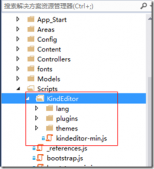一、用户
二、用户组
2.1浏览用户组
2.2添加用户组
2.3修改用户组
2.4删除用户组
删除用户组相对简单些,不用单独的页面,直接在浏览页面点击删除时,弹出确认删除对话框,点击确认,用jquery post删除。
打开【UserGroupController】,删掉public ActionResult Delele(int GroupId) { return View(); }
修改删除处理Action[Delete(int Id)],修改后的代码
|
1
2
3
4
5
6
7
8
9
10
11
12
13
|
/// <summary> /// 删除用户组 /// </summary> /// <param name="Id">用户组Id</param> /// <returns></returns> [HttpPost] [AdminAuthorize] public JsonResult Delete(int Id) { userGroupRsy = new UserGroupRepository(); if (userGroupRsy.Delete(Id)) return Json(true); else return Json(false); } |
这里返回类型为JsonResult目的方便使用jquery 的post方式删除。
打开List.cshtml,将@Html.ActionLink("删除", "Delete", new { id = item.UserGroupId }) 改为<a href="javascript:void(0)" onclick="Delete(@item.UserGroupId,'@item.Name')" >删除</a>
在文件底部添加脚本
|
1
2
3
4
5
6
7
8
9
10
|
function Delete(id,name) { if (confirm("你确定要删除【" + name + "】吗?")) { $.post("@Url.Content("~/UserGroup/Delete")", {Id:id}, function (data) { if (data) { alert("删除【" + name + "】成功!"); location.reload(); } }); } } |
完成后整个List.cshtml的代码如下:
|
1
2
3
4
5
6
7
8
9
10
11
12
13
14
15
16
17
18
19
20
21
22
23
24
25
26
27
28
29
30
31
32
33
34
35
36
37
38
39
40
41
42
43
44
45
46
47
48
49
50
51
52
53
54
55
56
57
58
59
60
61
62
63
64
65
66
67
68
69
|
@model IEnumerable<Ninesky.Models.UserGroup>@{ ViewBag.Title = "用户组列表"; Layout = "~/Views/Layout/_Manage.cshtml";}<div class="left"> <div class="top"></div> 左侧列表</div><div class="split"></div><div class="workspace"> <div class="inside"> <div class="notebar"> <img alt="" src="~/Skins/Default/Manage/Images/UserGroup.gif" />用户组列表 </div> <div class="buttonbar">@Html.ActionLink("添加用户组", "Add", "UserGroup") 用户组类型: @Html.DropDownList("GroupTypeList") </div> <table> <tr> <th> @Html.DisplayNameFor(model => model.Name) </th> <th> @Html.DisplayNameFor(model => model.Type) </th> <th> @Html.DisplayNameFor(model => model.Description) </th> <th></th> </tr> @foreach (var item in Model) { <tr> <td> @Html.DisplayFor(modelItem => item.Name) </td> <td> @Html.DisplayFor(modelItem => item.Type) </td> <td> @Html.DisplayFor(modelItem => item.Description) </td> <td> @Html.ActionLink("修改", "Edit", new { id = item.UserGroupId }) | <a href="javascript:void(0)" onclick="Delete(@item.UserGroupId,'@item.Name')" >删除</a> </td> </tr> } </table> </div></div><div class="clear"></div><script type="text/javascript"> $("#GroupTypeList").change(function () { window.location.href = "/UserGroup/List/" + $(this).children("option:selected").val(); }) function Delete(id,name) { if (confirm("你确定要删除【" + name + "】吗?")) { $.post("@Url.Content("~/UserGroup/Delete")", {Id:id}, function (data) { if (data) { alert("删除【" + name + "】成功!"); location.reload(); } }); } }</script> |
到此打完收工!
以上就是本文的全部内容,希望对大家的学习有所帮助,也希望大家多多支持服务器之家。
原文链接:http://www.cnblogs.com/mzwhj/archive/2012/11/15/2771014.html












